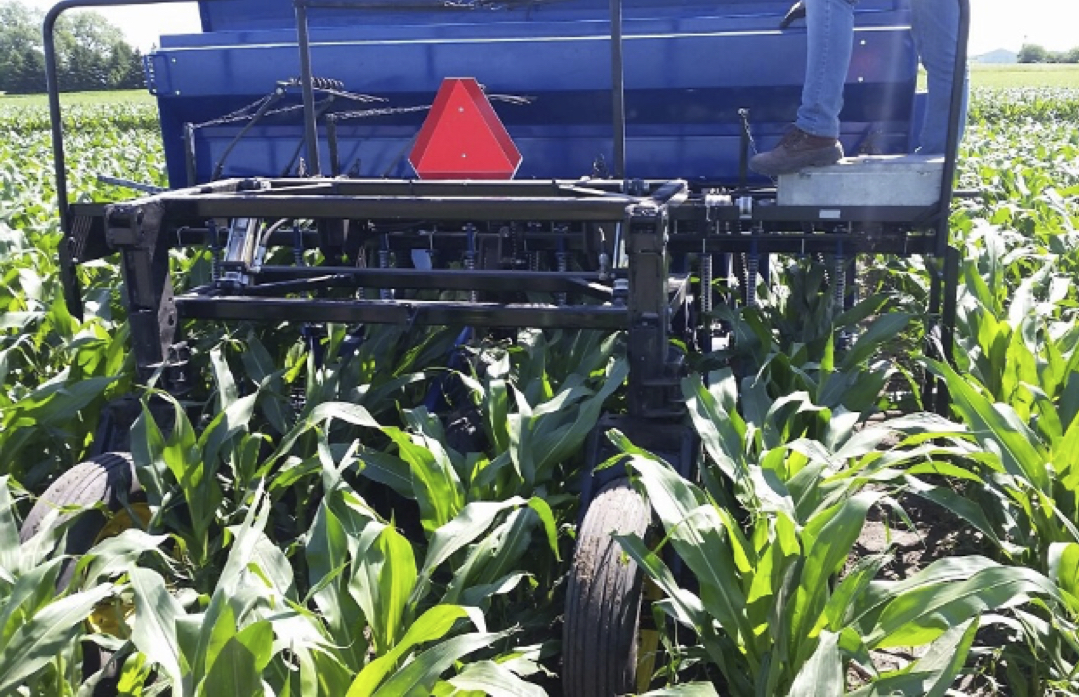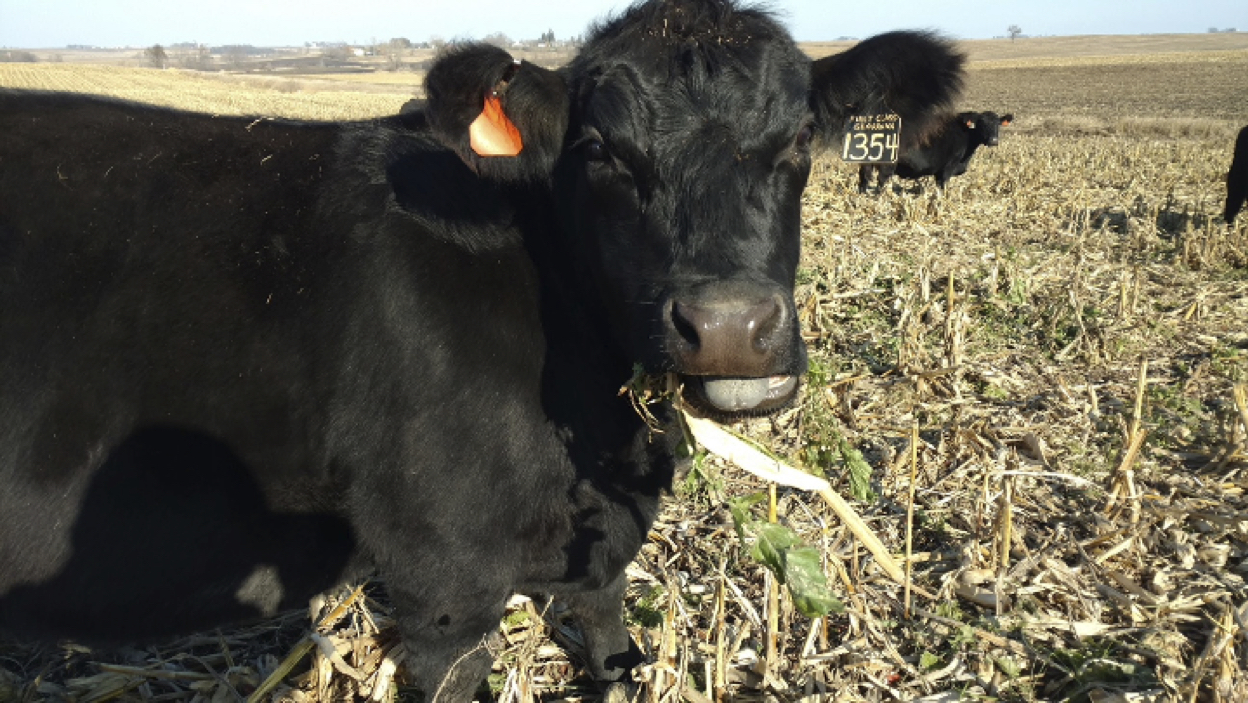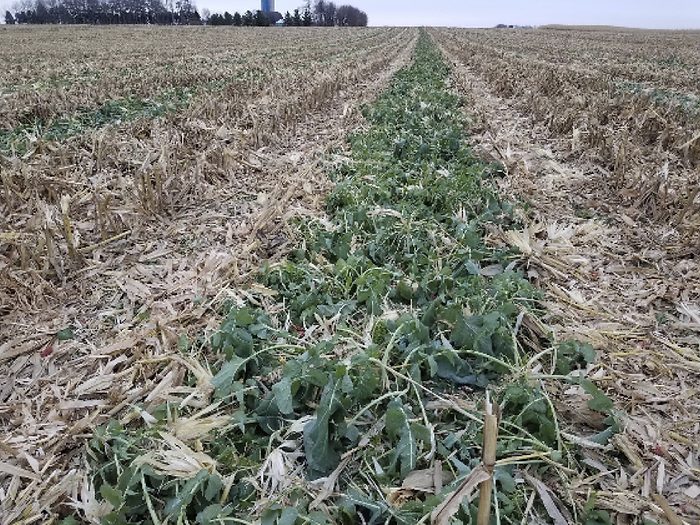By M. Scott Wells, Associate Professor, Department of Agronomy and Plant Genetics, University of Minnesota
Pictured Above: FINE FORAGES. High-quality cover crops (green) in a bed of harvested corn stalks. Goodhue, MN. Photo credit: Alan Kraus-CRWP.
Cover crop adoption across the U.S. is on the rise, but in Minnesota, The Land of 10,000 Lakes, adoption has hovered around 2%. Midwestern farmers understand the importance of soil health, however, they struggle to adopt sustainable technologies that offer limited near-term economic opportunities. Imagine the positive impacts Minnesotan farmers could have if sustainable technologies improved their economic outcomes on their 8 million acres of corn. Four southeastern Minnesota farmers, a small non-profit and the University of Minnesota are imagining a system that challenges the above narrative through exploring wide-spaced corn rows paired with cover crops with the expressed goals of improving economic and ecological outcomes.
When I grew up on a small farm in western North Carolina, growing 38-inch row-spaced tobacco was the common practice. Even though tobacco was one of the few crops that made consistent money on the farm, working in it was no fun. It wasn't until years later when I went to North Carolina State University for graduate studies that I learned why the rows were the size they were. Wide rows allowed enough space for a horse-drawn cultivator, which, believe it not, was still in use through the mid-1980s. My professor shared the prevailing understanding of the day that in general, wider-spaced crop rows reduced the amount of light captured by the cash crop, reducing yield and allowing the light to be used by competing weeds. I tell my students to think of plants as solar panels and sunlight as dollars waiting to be grabbed. For 40 years or more, crop rows have narrowed to maximize sunlight interception and subsequent profitability.
Row spacings vary between operations, crops, and locations across the U.S. but generally, corn is typically managed in 30-inch rows. Thirty-inch corn rows are broadly accepted as a best management practice with the highest return on investment. In 2018, I was challenged to question this best management practice by two individuals focused on improving both farm profit and water quality.
The first wide-row champion who reached out to me was Bob Recker, mastermind behind Cedar Valley Innovations based in Waterloo, Iowa. He shared his data from farms where he had planted corn in rows spaced 60 inches apart. Bob’s passion for finding sustainable solutions for corn and soybean acres across the upper Midwest was compelling. Yet as we chatted about his projects, and subsequent findings, I kept wondering how farmers could afford to adopt a technology that, in principle, would reduce corn yields.
The second individual who challenged me to question the widely accepted best management practice of narrow rows was Alan Kraus, Conservation Program Manager with Cannon River Watershed Partnership (CRWP) in southeastern Minnesota. He asked if I would be interested in partnering on a wide-row corn project. Initially, I was uninterested in researching the outcomes of wide-row corn. Over the last 40 years, researchers have been narrowing the row for obvious reasons. However, he asked, “What about the forage?” His idea was to provide farmers a dual-output system of corn grain and forage where both outcomes are economically linked to sustainability goals. I was sold.

KNEE HIGH IN JUNE AND JULY. A high-clearance drill made interseeding the forage cover crop mix a breeze in seven-leaf stage corn. Photo credit: M. Scott Wells, UMN.
Later in 2018, CRWP was awarded a Sustainable AGRI grant from the Minnesota Department of Agriculture to assess wide-row spaced corn productivity trade-offs. Kraus, a group of interested farmers and my team designed a field study that was implemented across four farms in southeast Minnesota counties, where each farm comprised of four, 5-acre replicates for a total of 80 acres across the network. Although the four farms were not strictly no-till in the classical sense, they did utilize a suite of conservation tillage technologies (e.g. shallow vertical tillage and no-till soybean). The row-spacing treatments included corn planted in 30-inch (with and without cover crop) and 60-inch (with cover crop) row spacings. Two cover crop mixtures were developed for both counties. The farmers picked the cover crops mixtures with the main goal of producing high forage yield and quality (e.g. annual ryegrass, clovers, kale, radish, turnip and cowpea). Cover crops were interseeded into knee-hi corn in mid-June to early July with modified drills and air-seeders. The goal of this project was to balance the potential corn grain reductions (due to wider rows) while providing improved forage biomass production for their cattle.
As we expected, overall the 60-inch wide-row corn treatments reduced corn yields per acre by 20% relative to the 30-inch treatments, both with and without a cover crop. On the other hand, a surprising finding was the amount of biomass the interseeded cover crop created in the 60-inch treatment. Yield data will be available in a follow-up article at a later date. In September, our sampling showed an average of more than 1,500 pounds per acre of high quality dried forage. For reference, my team has interseeded more than 2,000 cover crop test plots over the past 6 years, and fall cover crop biomass is typically less than 200 pounds per acre (dry matter). After corn harvest, cattle were sent to glean the field. One of the farmers stated that his cattle devoured the cover crop forage very quickly.

FORAGE FEAST. Cattle grazing cover crop forage and corn stalks at Jim Purfeerst’s Farm in Faribault, Minn. made their preferences known by devouring the forage quickly. Photo credit: Jim Purfeerst.
"I was interested in the wide row project because we were looking for more forage for our cattle to graze on post-harvest. We were happy with the end product, resulting in increased biomass for fall grazing. The beef cattle definitely preferred the cover crop foliage over cornstalk stubble".
— Jim Purfeerst, Farmer, Faribault, MN
A recent preliminary analysis by Dr. William Lazarus, agricultural economist with the University of Minnesota, revealed that high yielding cover crop forages (appox. 800 pounds per acre dry matter and greater) with high relative forage value can offset up to 10% of corn grain reductions through the production of milk and muscle, even without accounting for the soil health or environmental benefits. The results from the first year of this three year study showed that wide-row corn reduced per acre grain yields. The results also showed that when farmers have access to animals, wide-row corn, paired with cover crops that produce large quantities of high-quality forage can provide corn farmers with an improved bottom line by substituting high-cost hay with those grazed covers. Perhaps results like these will lead to greater adoption of planting cover crops and improved water quality for all Minnesotans.
For more information please feel free to contact either M. Scott Wells, University of Minnesota (email: mswells@umn.edu; twitter: @wellslabumn) or Alan Kraus, Cannon River Watershed Partnership Conservation Program Manager (alan@crwp.net).





Post a comment
Report Abusive Comment